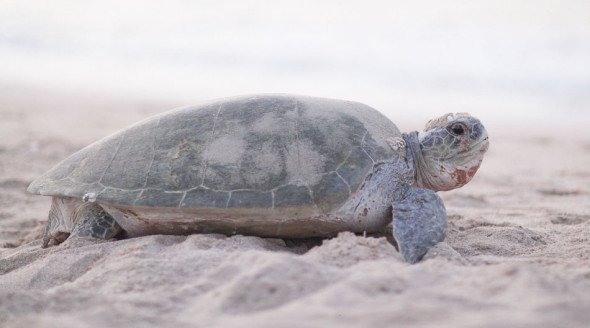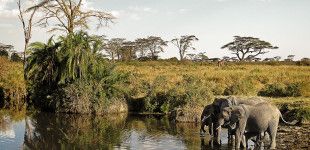Welcome travelers!
Natural Born Vagabond™ is a bilingual (English and Polish) site devoted to travel photography and journalism. Here you can find images and articles from our remote travels. The ambition of the creators is to share the best stories with those who crave wilderness and adventure. If you would like to share your opinions or travel stories please contact us via e-mail.
Featured
Natural Born Vagabond™
Oman adventures

1-metre-long female green sea turtle heads to the Indian Ocean after laying circa 200 eggs at the beach in the Ras Al-Jinz Turtle Watching Reserve.
A land that becomes more pleasurable on each visit
We have been to Oman on several occasions; each time we come back more impressed than before. The country has so much to offer: From beautiful landscapes to friendly locals to amazing natural wonders, and everything in between. Although the rough and rugged climate makes Oman’s rocky terrain appear unapproachable at times (especially when the mercury exceeds 40 Celsius), you will find — if you take the time to drill below the surface — a surprising amount of lush green nature waiting to be explored. Indeed, Oman is more than just desert and sand; it is a magical geological landscape that has a knack for luring intrepid travellers. Its gravity for the adventure seeker stems from its natural beauty: Mountains, deserts, caves, wadis, sink holes, coral reefs, turtle nesting beaches, etc. In fact, Oman is one of the world’s great destinations for cavers and desert trekkers. And for those fortunate enough to have visited Socotra (or at least read about it in our post: Socotra — dreams of the Lost Paradise), the geographic similarities with the “Pirate Island” are uncanny (and not unexpected given their proximity). Finally, one interesting historical note about Oman is that it is home to the legendary Quranic city of Ubar, a.k.a “the Atlantis of the sands”. This ancient lost city, as legend has it, is buried under the Rub Al-Khali sands in the Dhofar province of Oman. (A book worth checking before visiting is “Oman’s Geological Heritage” by Ken Glennie (2007).)

From left clockwise: Backstreets of the Muttrah Souk; Suburbs of the capital (Muscat); Muscat Gate; Shoreline villas.
Our first visit to Oman (Muscat) was in October 2011, on the so-called “Dubai visa run”. Dubai expatriates are prolific travellers to Oman because of its proximity to the UAE — the two share multiple contiguous borders on account of Oman’s interesting geography of having two exclaves bordering the UAE, one of which is wholly surrounded by the UAE (and contains an island of the UAE within it (i.e. it looks like a doughnut)!). The international border between the two nations enables expatriates in the UAE to renew their visas as they exit and re-enter the country. But more than just sorting out visa matters, Oman is a popular weekend getaway because of its many aforementioned qualities. Our initial foray into Oman was indeed a visa-run, allowing Dominika to switch from a UAE tourist visa to a UAE resident visa. And what better way is there to celebrate the peace of mind associated with fixing all the immigration matters than by enjoying the serene 5-star Shangri La resort situated just beyond the city limits of Muscat? Although we did pamper ourselves on the amenities at the Shangri La, we also spent time visiting the sites of Muscat (which included forts and the historical quarters of the city), people-watching on the corniche, and eating cheap shawarmas at the Muttrah Souk (which has a reputation for selling overpriced goods to tourists).
Our second planned jaunt to Oman (2012), however, was a little less fortunate; we did not manage to get through the border (from Ras Al-Khaimah (RAK)) into Musandam, the northern exclave of Oman that juts into the Strait of Hormuz. The reason for our bad luck was that we were travelling with a rental car and had not arranged to bring it across the border, which requires special permission (and a fee) from the rental agency. Despite the fact that Oman and the UAE are both members of the Gulf Cooperation Council (GCC) — a political union of the countries of the Arabian Peninsula (excluding Yemen) — and on friendly terms, this piece of bureaucracy impeded us from our planned trip. (The rule is in place probably to prevent the smuggling of cars to Iran as Musandam is the closest point on the Arabian Peninsula to Iran.) With the plan for Musandam foiled by the need for a cross-border-car-rental permit (and there not being any rental agency at the border and the fact that the agency from which we rented the car in Dubai was closed due to it being a public holiday) we instead opted to stay on the UAE side and explore the beaches and villages of the emirate of RAK.
Our third excursion to Oman (if we count the attempted but unsuccessful in crossing the border trip (see above)) was a road trip to Muscat with two fellow expat friends from Abu Dhabi. This time we had the cross-border issue settled and were able to drive our rental vehicle all the way from the UAE (beginning at Abu Dhbai with our friends and then through to Dubai) to Muscat. On this journey we discovered the wonderful beach by the Oman Dive Centre, as well as the famous Thursday seafood night at the Tropicana Restaurant in the Crowne Plaza Muscat Hotel. (Since then, the seafood special has become a must-do for us whenever we are in Muscat.)

Fishing trip to Musandam on a traditional wooden boat (dhow). Our captain and local fishing guide taught us the Omani-way of catching fish — with just a hook tethered to a spool of fishing rope (and no rod).
Our fourth excursion (February 2013) to Oman was a trip to the town of Khasab in Musandam with a tour operator (Musandam Sea Adventure Travel & Tourism), where we spent two days on a traditionally decorated dhow. The first day was spent dolphin watching, snorkeling and admiring the rugged coastline from the vantage-point of the dhow, as we sailed in the Strait of Hormuz (the narrow body of water separating the UAE/Oman and Iran). In addition to the marine life, we were also treated to a rare sighting of the Arabian tahr which we saw perched on the cliffs overlooking the waters. And no jaunt in the Strait of Hormuz is complete without seeing masked smugglers with machine guns strapped on their shoulders in speedboats racing between Iran and Musandam, which was at once a comical yet nerve-racking site — especially when they stopped to speak with our crew in a language we did not understand. At one point our imaginations were racing thinking that we would be sold/surrendered to the smugglers. Nothing came of the smugglers, although it did add an extra dash of excitement into an already interesting day! As the day drew to an end the crew made landfall on a deserted beach where a tent was set up for us just in time before sunset. Our guides then prepared a hearty meal over a bonfire with grilled fish as the main course. When the fire died and we readied ourselves for a night of sleep, the lure of fish leftovers and the protection of darkness brought a few brave desert foxes roaming near our campsite, whose sight we caught with the corner of our eyes.
The second day was reserved for fishing. The prized fishes in the Strait are hammours (groupers), although there are an amazing variety of fish to be found in the waters. We employed traditional Omani technology — using only a spool of fishing line (30-40 metres; no rod) with weight and hooks fastened on the end — to snag scores of fish that day amongst the three of us (Dominika’s sister joined us for this trip). In spite of its odd/awkward appearance, the Omani technique of fishing without a rod is actually quite simple: We secured squid bait on the hooks and let the rope down all the way to the sea bottom and then just as quickly pulled in the line back. When successful (which was quite often), we pulled in two groupers at a time back onto the boat deck without much of a struggle by just pulling the line in with our bare hands. Most importantly, we learned from our captain that murmuring the Arabic words “hammour, hammour” while pulling the line up helps with a better catch ;-)

Turtle watching at Ras Al-Jinz Turtle Watching Reserve (top). Garra rufa fish working on our toes at the Sinkhole Park pond (bottom).
Our latest trip to Oman was to attend a Diana Krall concert — an artist on Dominika’s top-5 list of living female performers — at the Royal Opera House Muscat (with an acoustics to rival any site in the world). In addition to enjoying a great jazz performance in Muscat while staying at a beach-side hotel, we also appended a mini road trip from Muscat (we flew in from Dubai) to the Ras Al-Jinz Turtle Reserve (and back to Muscat) that led us through spectacular wadis spread across the Hajar Mountains adjacent to the Gulf of Oman. Highly recommended stops along the highway (that hugs the coast) are Wadi Al-Shab and Wadi Tiwi with their breath-taking views of the Gulf and the coast. With temperatures surpassing 42 centigrade, even the winds did not bring any relief, so we were grateful to dip in the cold fresh-water streams of the wadis we visited. The wadis are also a great place to take in picturesque traditional towns built adjacent to the life-giving waters. The cramped houses built of stones and narrow streets of the wadi villages offer an interesting contrast to the site of Middle-Eastern villas more commonly seen in the region.
The highlight of the road trip, though, was to see gigantic green turtles (spanning over 1 metre from head to tail) nesting at the beach in the Ras Al-Jinz Turtle Reserve. We even had the great fortune to see baby green turtles, recently hatched from their eggs, making their way to the ocean. With luck, the little ones will swim all the way to Seychelles and return to the same beach as adults to lay eggs and repeat the cycle. (Unfortunately, only about one in a thousand eggs laid by the turtle will be successful in this feat.) If the sight of the turtles was not enough, we were also able to see the Milky Way in the night sky, as well as to be mesmerised by the sight of glow-in-the-dark plankton in the waters by the beach. The sight of so many “stars” in the water drew us into the Gulf as we scooped up the water in our hands to get a closer glimpse of the illuminated plankton. Altogether, the experience was so inspiring that we decided to catch two viewings: One at night and one at dawn. (We killed the time between “sleeping” in our rental car in the parking lot.)
And if the turtle-watching adventure was not enough, on our way back to Muscat we happened upon a sinkhole pool (30 metres below ground level) where we were treated to a pleasant surprise of a foot pedicure by the garra rufa fish that inhabit the pool. The fish are more commonly known as the “doctor fish” and will eat the dead skin on human feet, which is why they have become popular items at certain spas. The sinkhole is located in Hawiyat Najm Park on route from Quriyat to Sur, midway between the towns Dibab and Bimah, and is not easy to find, but well worth the visit! (Kai’s feet were noticeably fresher/cleaner after the experience!)
We are already thinking about the next road trip to Oman. Now that we have our own 4-wheel-drive vehicle the thought of a trip from Dubai along the the coast of Oman to Salalah is no longer a fanciful dream. When that time comes, we will be sure to search for the lost city of Ubar!
© Natural Born Vagabond, 2014


















